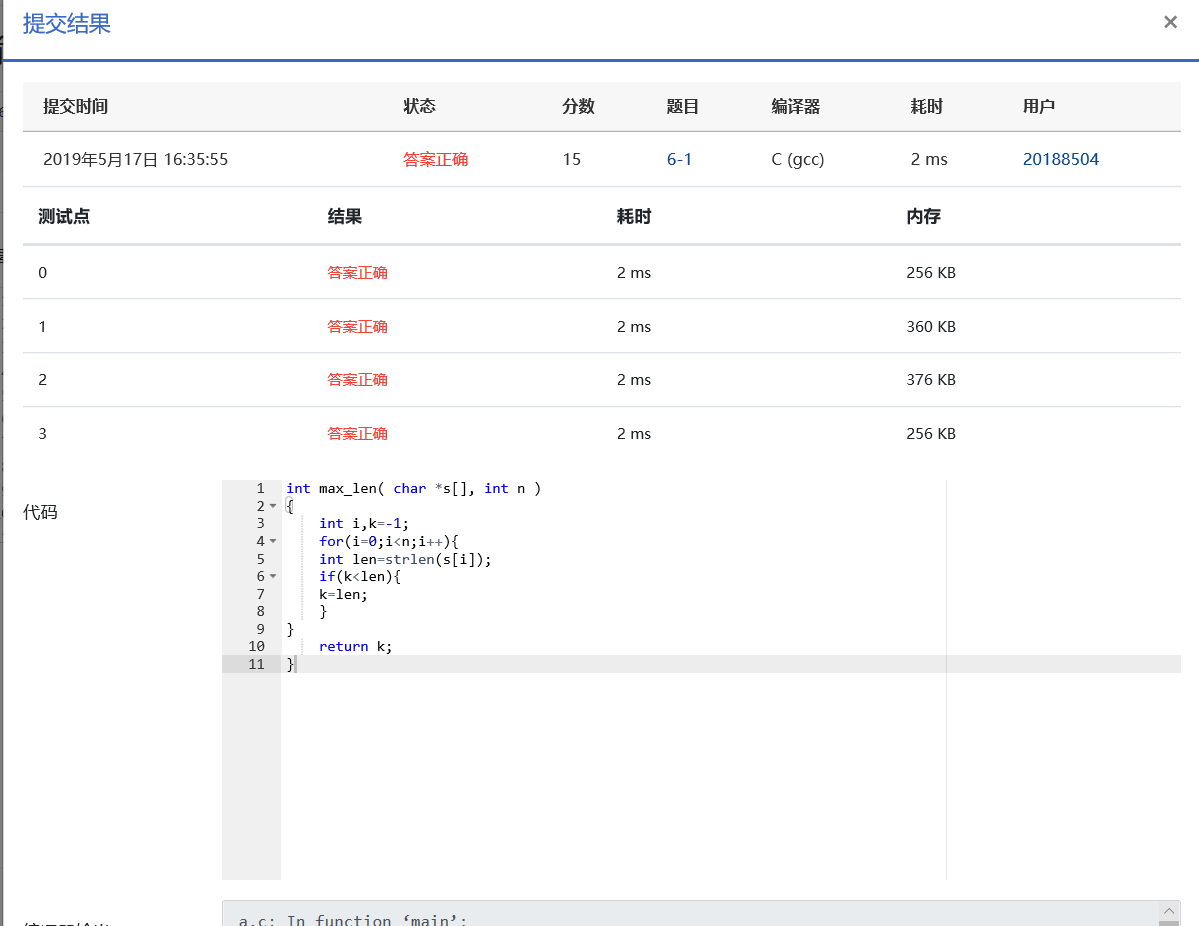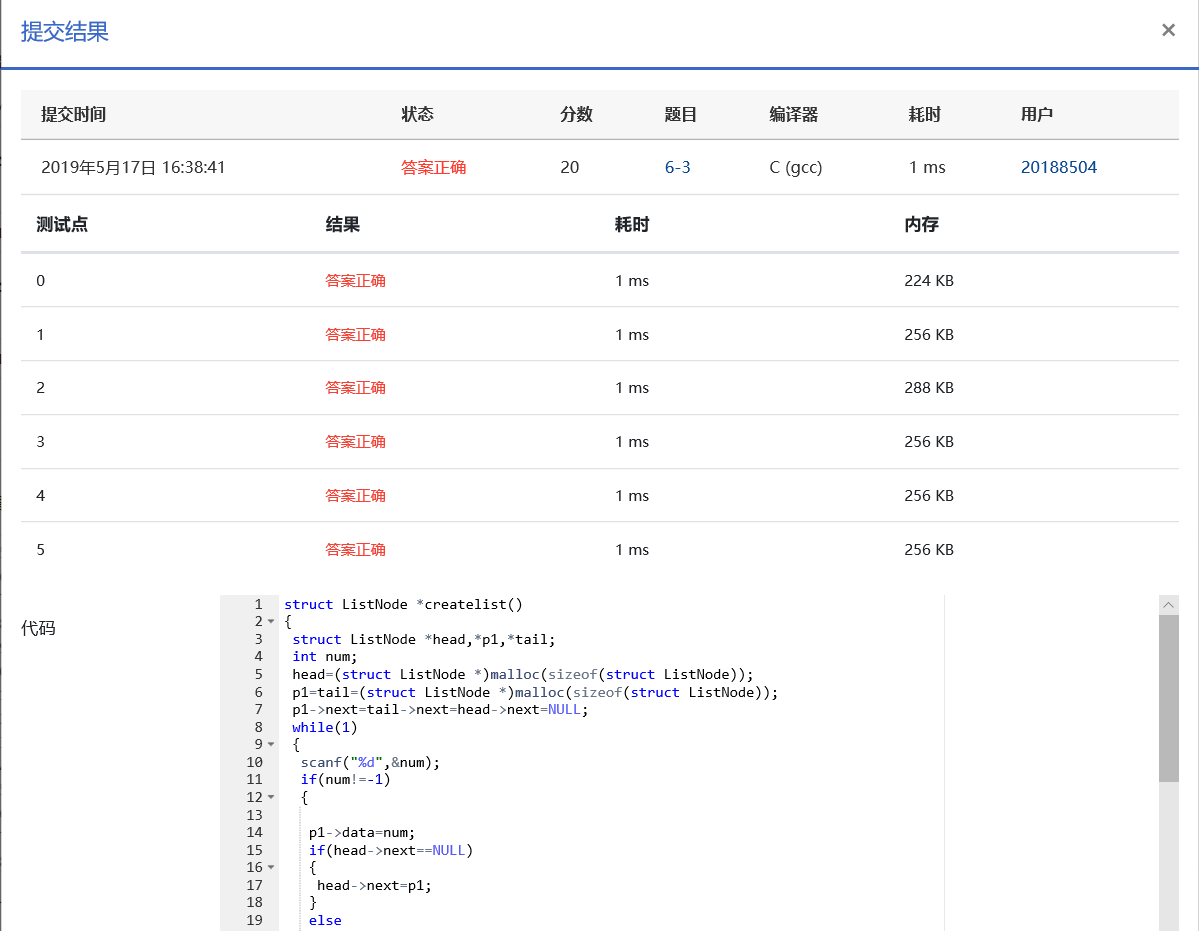十二周作业
| 这个作业属于那个课程 | 指针进阶 |
| 这个作业要求在哪里 | https://www.cnblogs.com/pengchen511/p/10564067.html |
| 我在这个课程的目标是 | 掌握函数指针,链表等 |
| 这个作业在那个具体方面帮助我实现目标 | 解决了处理字符的问题 |
| 参考文献 | C语言程序设计 |
6-1 计算最长的字符串长度 (15 分)
本题要求实现一个函数,用于计算有n个元素的指针数组s中最长的字符串的长度。
函数接口定义:
int max_len( char *s[], int n );其中n个字符串存储在s[]中,函数max_len应返回其中最长字符串的长度。
裁判测试程序样例:
#include <stdio.h>
#include <string.h>
#include <stdlib.h>
#define MAXN 10
#define MAXS 20
int max_len( char *s[], int n );
int main()
{
int i, n;
char *string[MAXN] = {NULL};
scanf("%d", &n);
for(i = 0; i < n; i++) {
string[i] = (char *)malloc(sizeof(char)*MAXS);
scanf("%s", string[i]);
}
printf("%d\n", max_len(string, n));
return 0;
}
/* 你的代码将被嵌在这里 */输入样例:
4
blue
yellow
red
green输出样例:
6
实验代码:
int max_len( char *s[], int n )
{
int i,k=-1;
for(i=0;i<n;i++){
int len=strlen(s[i]);
if(k<len){
k=len;
}
}
return k;
}
正确截图:

6-2 统计专业人数 (15 分)
本题要求实现一个函数,统计学生学号链表中专业为计算机的学生人数。链表结点定义如下:
struct ListNode {
char code[8];
struct ListNode *next;
};
这里学生的学号共7位数字,其中第2、3位是专业编号。计算机专业的编号为02。
函数接口定义:
int countcs( struct ListNode *head );
其中head是用户传入的学生学号链表的头指针;函数countcs统计并返回head链表中专业为计算机的学生人数。
裁判测试程序样例:
#include <stdio.h>
#include <stdlib.h>
#include <string.h>
struct ListNode {
char code[8];
struct ListNode *next;
};
struct ListNode *createlist(); /*裁判实现,细节不表*/
int countcs( struct ListNode *head );
int main()
{
struct ListNode *head;
head = createlist();
printf("%d\n", countcs(head));
return 0;
}
/* 你的代码将被嵌在这里 */
输入样例:
1021202
2022310
8102134
1030912
3110203
4021205
#
输出样例:
3
实验代码:
int countcs( struct ListNode *head )
{
int num = 0;
struct ListNode *p = head;
while(p != NULL)
{
if(p->code[1] == '0' && p->code[2] == '2')
num++;
p = p->next;
}
return num;
}
正确截图:

6-3 删除单链表偶数节点 (20 分)
本题要求实现两个函数,分别将读入的数据存储为单链表、将链表中偶数值的结点删除。链表结点定义如下:
struct ListNode {
int data;
struct ListNode *next;
};
函数接口定义:
struct ListNode *createlist();
struct ListNode *deleteeven( struct ListNode *head );
函数createlist从标准输入读入一系列正整数,按照读入顺序建立单链表。当读到−1时表示输入结束,函数应返回指向单链表头结点的指针。
函数deleteeven将单链表head中偶数值的结点删除,返回结果链表的头指针。
裁判测试程序样例:
#include <stdio.h>
#include <stdlib.h>
struct ListNode {
int data;
struct ListNode *next;
};
struct ListNode *createlist();
struct ListNode *deleteeven( struct ListNode *head );
void printlist( struct ListNode *head )
{
struct ListNode *p = head;
while (p) {
printf("%d ", p->data);
p = p->next;
}
printf("\n");
}
int main()
{
struct ListNode *head;
head = createlist();
head = deleteeven(head);
printlist(head);
return 0;
}
/* 你的代码将被嵌在这里 */
输入样例:
1 2 2 3 4 5 6 7 -1
输出样例:
1 3 5 7
实验代码:
struct ListNode *createlist()
{
struct ListNode *head,*p1,*tail;
int num;
head=(struct ListNode *)malloc(sizeof(struct ListNode));
p1=tail=(struct ListNode *)malloc(sizeof(struct ListNode));
p1->next=tail->next=head->next=NULL;
while(1)
{
scanf("%d",&num);
if(num!=-1)
{
p1->data=num;
if(head->next==NULL)
{
head->next=p1;
}
else
{
tail->next=p1;
tail=p1;
}
p1=(struct ListNode *)malloc(sizeof(struct ListNode));
p1->next=NULL;
}
else
break;
}
return head;
}
struct ListNode *deleteeven(struct ListNode *head)
{
struct ListNode *num,*p;
p=head;
num=head->next;
while(num!=NULL)
{
if(num->data%2==0)
{
p->next=num->next;
}
else
p=p->next;
num=num->next;
}
return head->next;
}
正确截图:




